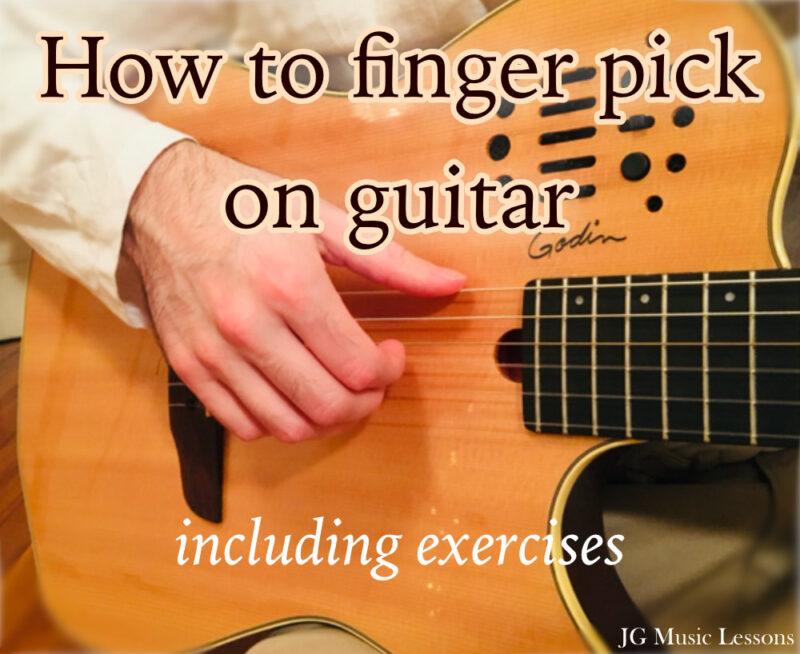Fingerpicking or finger-style playing is a method of playing guitar strings using your fingers as opposed to using a pick that you grip between your fingers.
The fingerpicking technique is a beautiful style of playing which opens up many sound possibilities on the guitar. This style ranges from being able to play single note melodies up to complex arrangements that can connect a melody, chords and bass notes together.
This lesson covers:
- Symbols used for fingerpicking
- How to position your hand and fingers
- How to read sheet music that uses fingerpicking
- Fingerpicking exercises to improve your technique
Let’s get started!
Comparison between fingerpicking and using a pick
Before we move on, you can compare the two most common picking methods in the images below.
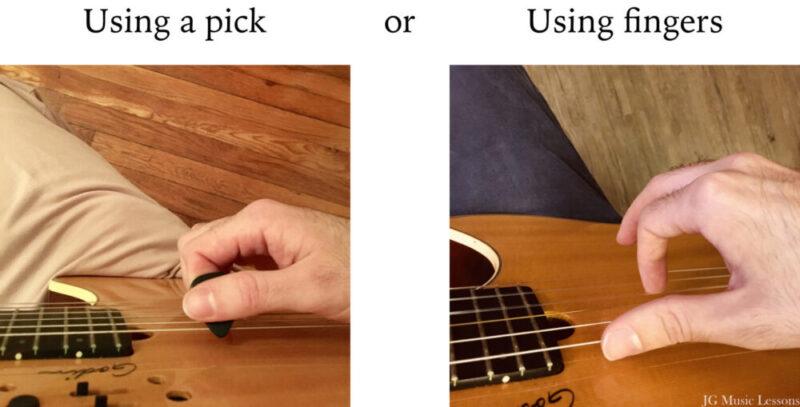
If you are still trying to figure out which technique suits you best, you can also check out this post which compares using your fingers vs. using a pick. Now, let’s learn the symbols that are used for fingerpicking.
Symbols used for fingerpicking (p, i, m, a, c)
The symbols used for yours picking fingers come from Spanish words and have become a standard way to notate them in sheet music.
Here are the meaning of the abbreviations used for finger picking:
- ‘p’ is for pulgar or thumb in English.
- ‘i’ is for indice or index (pointer) finger
- ‘m’ is for medio or middle finger
- ‘a’ is for anular or ring finger
- ‘c’ is for chico or pinky (It is not often used until you get to more advanced pieces but we’ll still include it here for now)
These ‘pimac’ symbols are often used in classical music but they can also be found in modern finger style song arrangements.
Take a look at the symbols used for the picking hand in the chart below.
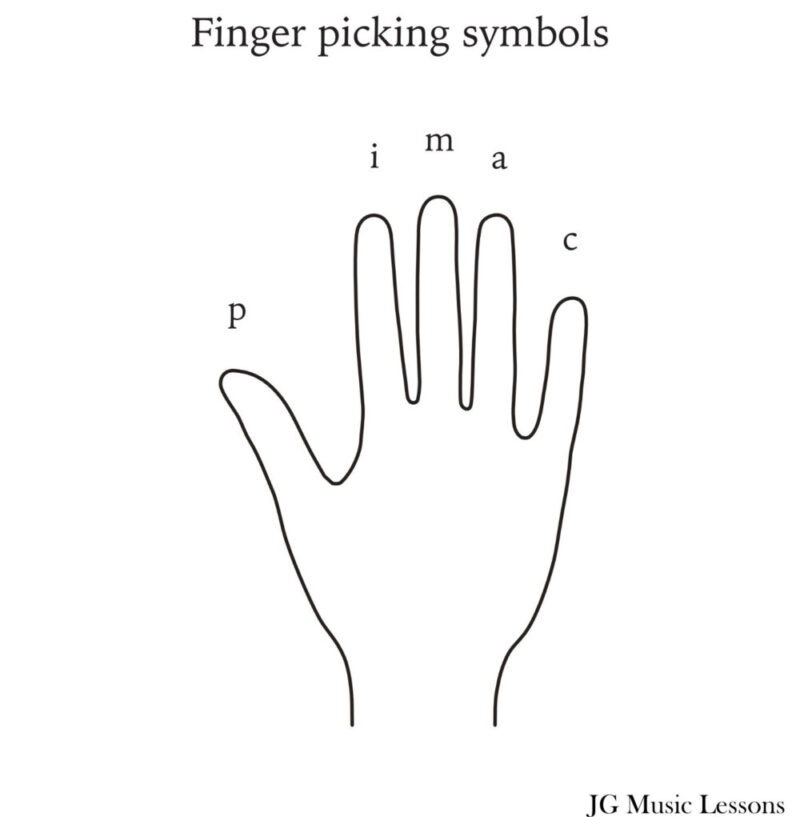
How to position your hand and fingers
First of all, your arm used to pick should rest comfortably on the body of the guitar as you’ll in the image below. As you do this, your hand should meet the strings diagonally. You shouldn’t need to rotate your wrist too much when playing the strings.
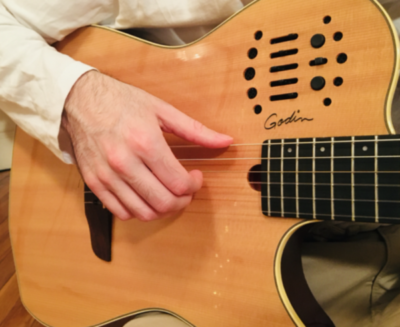
Technique 1: Single note picking (alternating index and middle finger)
As you can see in the images below, you will want to alternate between your index and middle finger when playing a series of notes. I recommend you keep alternating between these fingers even when you have to switch to another string.
As you pick a string, you can let it rest on the string above it until you use the next finger. I recommend resting your thumb on the 6th string as you can see in the pictures below.
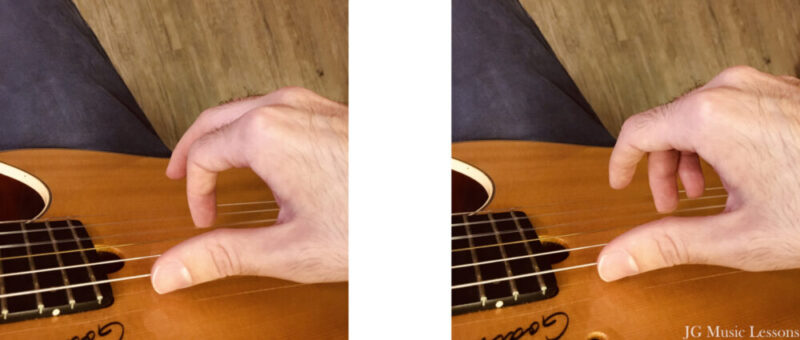
Technique 2: Using all of your fingers
For this technique, your index, middle and ring finger move up towards your palm after playing the string but your thumb will move down when playing a string.
Generally I would use my thumb to play the 6th and 5th string and then use my index, middle and ring finger to play the 4th, 3rd and 2nd string or if I need to play on the higher strings, these fingers would be on the 3rd, 2nd and 1st string. These three fingers are often grouped together when playing several notes at the same time and other chord parts.
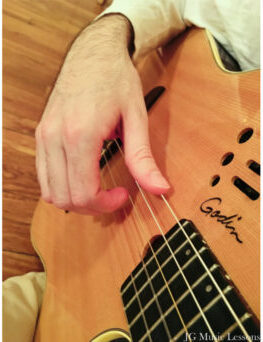
How to read sheet music using fingerpicking symbols
When reading sheet music, the p, i, m, a symbols will be indicated either beside or above a note when playing finger style. For example:
Fingerpicking example 1

Fingerpicking example 2
Here is another example using all of your fingers. I am holding down a C Major chord for measures 1, 2, and 4 and G chord on measure 3.

Fingerpicking exercises
We’ll go through 5 different exercises starting from easiest to more difficult. You can try using a metronome at slow tempo and gradually increase it to help you keep good timing and see your progress. A good picking technique at a slow tempo is better than trying to play fast and sloppy which can create bad habits in your fingerpicking technique.
If needed, here is a free metronome on our site.
Exercise 1 – Alternating between index and middle finger (2 notes per string)
This first exercise is good for learning to play single notes starting with open strings only.
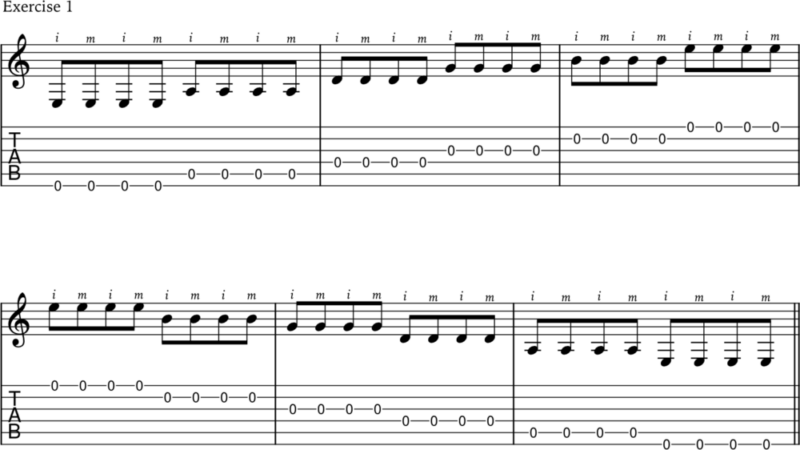
Exercise 2 – Alternating between index and middle finger (3 notes per string)
This next exercise becomes slightly more challenging because you have to start a new string with a different finger than you did a previous string when playing 3 notes per string.
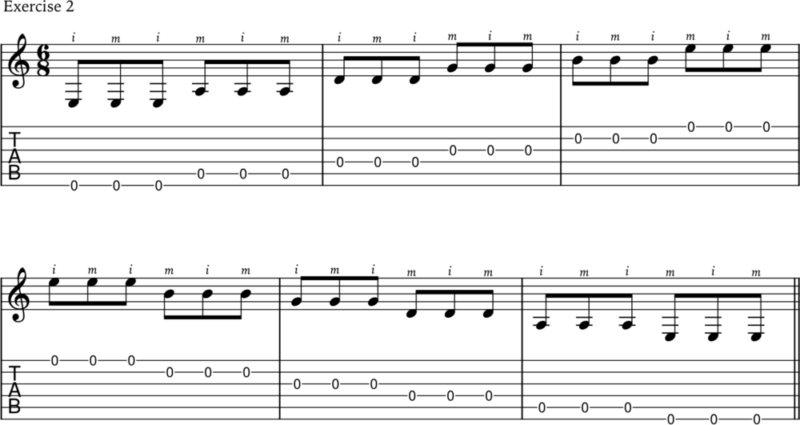
Exercise 3 – Arpeggios (using all fingers)
An arpeggio is when you take a chord and separate the notes as you’ll see in the notation below. This exercise now includes all your fingers (except pinky) which you can use for any chord but we are simply starting out with open strings to start to get comfortable with the technique.
Your thumb is switching between the 6th and 5th string after each measure and your index, middle and ring finger also switch positions in measures 3 and 4.


Exercise 4 – Chords (using all fingers)
For this next exercise, you are using all your fingers again but this time playing several notes at the same time by holding down a chord.
As your index, middle and ring finger pull up and towards your palm, your thumb will be picking by moving down on the lowest note of the chord.

Exercise 5 – Mixing all techniques (single notes, arpeggios, and chords)
This last exercise is more of an example of what it looks like to combine all the previous exercises which includes single notes, arpeggios and chords.

To learn more advanced fingerpicking patterns, check out how to Travis pick on guitar.
Wrapping up
Now that you have a better understanding of how fingerpicking works, you can start learning simple pieces with this technique and then gradually work your way up to more advanced pieces or warm up exercises.
After you develop the basic picking skills covered here, I recommend learning fingerpicking patterns to create interesting rhythms for your chords. If you want to take your technique to the next level, check out these 7 ways to get better at finger picking on guitar.
As you become more comfortable picking with your fingers it becomes really fun to hear yourself play multiple parts of a song. Although some people feel that using a pick is easier, I think the fingerpicking style of playing is worth the learning curve in order to advance your skills and discover new musical possibilities on your instrument.
You can also check out the songs with tabs resource on this site to learn and practice songs that use fingerpicking.
📘 Get the free guitar practice guide here!
All the best,
JG Music Lessons
📙 Kickstart your guitar playing with our step by step guide: Guitar Essentials.
🎸 Looking for a travel or half-sized guitar? See this one.
🛠 See our other music recommendations.
🤝 Support the site to help us to create better content for you!
Level up with the FREE guitar practice guide and effectively improve your playing! 🎸
Get it sent to your email!

